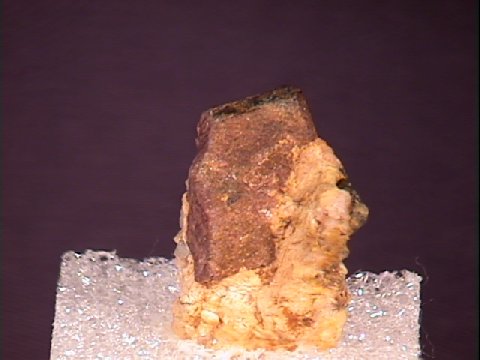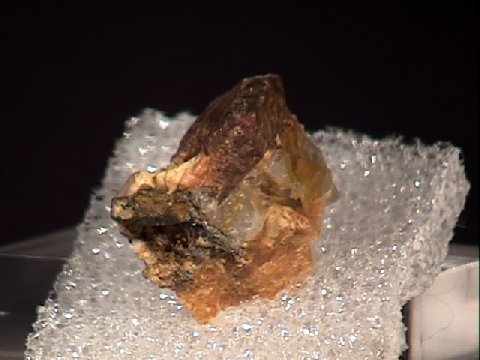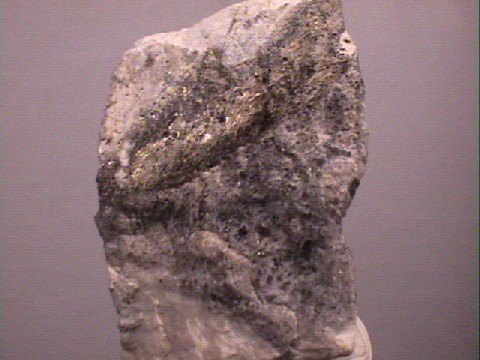 THE
MINERAL MONAZITE
THE
MINERAL MONAZITE
- Chemistry: (Ce, La, Th, Nd, Y)PO4, Cerium Lanthanum Thorium Neodymium Yttrium Phosphate.
- Class: Phosphates
- Group:
Monazite - Uses: As an ore of rare earth metals especially thorium, cerium and Lanthanum, radioactive dating uses and as mineral specimens.
Specimens
Monazite is actually three different minerals technically, but because of a lack of great differences between them they are referred to as one mineral, monazite. The three monazites have differences in the percentages of their chemical makeup and these differences are reflected in their respective names.
| NAME: | FORMULA: |
| MONAZITE-(Ce) | (Ce, La, Nd, Th, Y)PO4 |
| MONAZITE-(La) | (La, Ce, Nd)PO4 |
| MONAZITE-(Nd) | (Nd, La, Ce)PO4 |
The differences in the formula represent the greater percentages of certain elements in the mineral. The first element listed in the parenthesis is the element with the greater percentage in the mineral; so that monazite-(La) is greatly enriched in lanthanum, etc. Monazite-(Ce) is not only enriched in cerium it is also by far the most common of the three and is probably the actual mineral when one encounters a specimen that is simply labeled monazite. The general formula represents an aggregate formula for monazite. Silica or SiO4, will often be present in monazite replacing a small percentage of the phosphate groups, but this is not typically shown in monazite's formula. Uranium is also a trace element in some specimens.
The name monazite comes from a Greek word, monazein, which means "to be alone". It is an apt name as it is an allusion to the typical crystal habit of primary origin for monazite as isolated individual crystals in phosphatic pegmatites. Solitary crystals all alone in a dissimilar crystalline matrix. The name does seem to fit.
Monazite is a primary ore of several rare earth metals most notably thorium, cerium and lanthanum. All these metals have various industrial uses and are considered quite valuable. Thorium is a highly radioactive metal and could be used as a replacement for uranium in nuclear power generation. Monazite therefore is an extremely important ore mineral.
Monazite is radioactive, sometimes highly radioactive, and specimens are often metamict. This is a condition found in radioactive minerals and results from the destructive effects of its own radiation on its crystal lattice. The effect can destroy a crystal lattice completely while leaving the outward appearance of the crystal unchanged. Increased metamictation will increase the perfection of the specimens conchoidal fracture. The radioactivity of monazite has been used as an aid in radioactive dating.
Monazite, as already mentioned, forms in phosphatic pegmatites but is actually a standard trace constituent in many ordinary igneous, metamorphic, and vein filling rocks. If not too metamict, crystals of monazite are rather durable. They can be weathered out from their host rocks and carried downstream great distances and collect in river deposits and even in ocean beach deposits. Their great density (specific gravity is 4.6 - 5.7) makes it easy for the crystals to be collected into what are called placer deposits.
Placers, as they are informally called, are deposits where heavier objects settle while lighter objects such as quartz sands are constantly removed by the force of water. This process naturally concentrates some pretty valuable stuff. Ores such as rutile and monazite, metals such as gold and platinum and gemstones such as diamonds, rubies, sapphires and spinels, to name a few, are all found in placers. Some monazite beach placers in India alone are so rich that they could supply the entire world's need for monazite for many years to come.
Crystals of monazite are generally simple equant to prismatic crystals that show their monoclinic symmetry without any pretense. Twinning is common and produces crosses and angled reentrant crystals. Specimens of monazite are sought after for their unique chemistry, nice monoclinic form and some specimens are actually quite attractive. Remember, this is a radioactive mineral and should be stored away from other minerals that are subject to damage from radioactivity, and of course human exposure should be limited !
PHYSICAL CHARACTERISTICS:
- Color is yellow to brown or orange-brown.
- Luster is vitreous, resinous or adamantine.
- Transparency: Specimens are translucent to opaque, but small crystals can be transparent.
- Crystal System is monoclinic; 2/m
- Crystal Habits include equant to prismatic crystals with wedge-shaped terminations. Crystals are rarely flattened or tabular. Twinning is common forming crosses and variously angled reentrant crystals. Typical habit is granular or massive with no distinct form.
- Cleavage is perfect in one direction, poor in several other directions. The result is often shards or acutely angled splinters.
- Fracture is uneven but gradationally converts to conchoidal with metamictation.
- Hardness is variable from 5 - 5.5
- Specific Gravity is approximately 4.6 - 5.7 (heavy for translucent minerals)
- Streak is white.
- Other Characteristics: Generally highly radioactive which can produce metamictation! A basal parting direction is sometimes noticeable. Crystal surfaces are often etched and pitted.
- Associated Minerals include apatite,
columbite,
zircon,
xenotime,
fergusonite , samarskite, feldspars, quartz, euxenite,polycrase and biotite. - Notable Occurrences are wide spread and diverse. They include beach and river sand deposits from Travancore, India; Australia; Brazil; Sri Lanka; Malaysia; Nigeria; Florida and North Carolina, USA. Pegmatite sources include Encampment, Wyoming; Petaca District, New Mexico; Amelia Court House, Virginia; Climax Mines, Colorado; Maine; Alexander and Madison Counties, North Carolina, USA as well as Callipampa, Bolivia; Madagascar; Norway; Austia; Switzerland; Joaquim Felicio, Minas Gerais, Brazil and Finland.
- Best Field Indicators are crystal habit, color, cleavage shards, high specific gravity, hardness and radioactivity.





